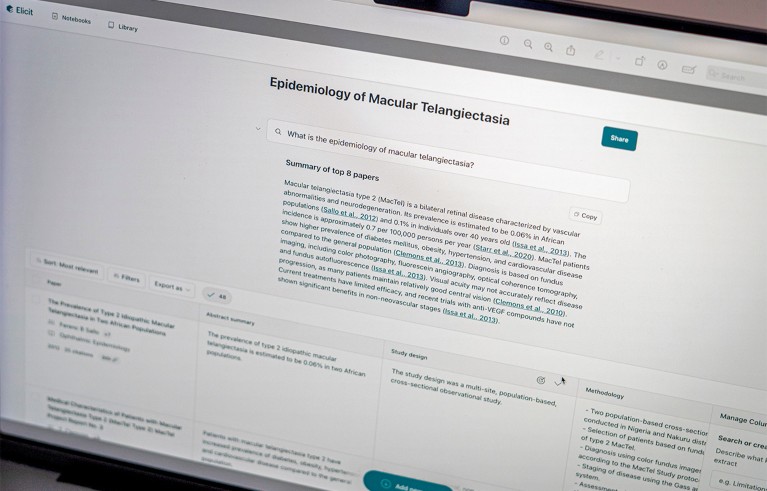When Sam Rodriques was a neurobiology graduate student, he was struck by a fundamental limitation of science. Even if researchers had already produced all the information needed to understand a human cell or a brain, “I’m not sure we would know it”, he says, “because no human has the ability to understand or read all the literature and get a comprehensive view.”
Five years later, Rodriques says he is closer to solving that problem using artificial intelligence (AI). In September, he and his team at the US start-up FutureHouse announced that an AI-based system they had built could, within minutes, produce syntheses of scientific knowledge that were more accurate than Wikipedia pages1. The team promptly generated Wikipedia-style entries on around 17,000 human genes, most of which previously lacked a detailed page.
How AI-powered science search engines can speed up your research
Rodriques is not the only one turning to AI to help synthesize science. For decades, scholars have been trying to accelerate the onerous task of compiling bodies of research into reviews. “They’re too long, they’re incredibly intensive and they’re often out of date by the time they’re written,” says Iain Marshall, who studies research synthesis at King’s College London. The explosion of interest in large language models (LLMs), the generative-AI programs that underlie tools such as ChatGPT, is prompting fresh excitement about automating the task.
Some of the newer AI-powered science search engines can already help people to produce narrative literature reviews — a written tour of studies — by finding, sorting and summarizing publications. But they can’t yet produce a high-quality review by themselves. The toughest challenge of all is the ‘gold-standard’ systematic review, which involves stringent procedures to search and assess papers, and often a meta-analysis to synthesize the results. Most researchers agree that these are a long way from being fully automated. “I’m sure we’ll eventually get there,” says Paul Glasziou, a specialist in evidence and systematic reviews at Bond University in Gold Coast, Australia. “I just can’t tell you whether that’s 10 years away or 100 years away.”
At the same time, however, researchers fear that AI tools could lead to more sloppy, inaccurate or misleading reviews polluting the literature. “The worry is that all the decades of research on how to do good evidence synthesis starts to be undermined,” says James Thomas, who studies evidence synthesis at University College London.
Computer-assisted reviews
Computer software has been helping researchers to search and parse the research literature for decades. Well before LLMs emerged, scientists were using machine-learning and other algorithms to help to identify particular studies or to quickly pull findings out of papers. But the advent of systems such as ChatGPT has triggered a frenzy of interest in speeding up this process by combining LLMs with other software.
AI science search engines are exploding in number — are they any good?
It would be terribly naive to ask ChatGPT — or any other AI chatbot — to simply write an academic literature review from scratch, researchers say. These LLMs generate text by training on enormous amounts of writing, but most commercial AI firms do not reveal what data the models were trained on. If asked to review research on a topic, an LLM such as ChatGPT is likely to draw on credible academic research, inaccurate blogs and who knows what other information, says Marshall. “There’ll be no weighing up of what the most pertinent, high-quality literature is,” he says. And because LLMs work by repeatedly generating statistically plausible words in response to a query, they produce different answers to the same question and ‘hallucinate’ errors — including, notoriously, non-existent academic references. “None of the processes which are regarded as good practice in research synthesis take place,” Marshall says.
A more sophisticated process involves uploading a corpus of pre-selected papers to an LLM, and asking it to extract insights from them, basing its answer only on those studies. This ‘retrieval-augmented generation’ seems to cut down on hallucinations, although it does not prevent them. The process can also be set up so that the LLM will reference the sources it drew its information from.
This is the basis for specialized, AI-powered science search engines such as Consensus and Elicit. Most companies do not reveal exact details of how their systems work. But they typically turn a user’s question into a computerized search across academic databases such as Semantic Scholar and PubMed, returning the most relevant results.
An LLM then summarizes each of these studies and synthesizes them into an answer that cites its sources; the user is given various options to filter the work they want to include. “They are search engines first and foremost,” says Aaron Tay, who heads data services at Singapore Management University and blogs about AI tools. “At the very least, what they cite is definitely real.”
These tools “can certainly make your review and writing processes efficient”, says Mushtaq Bilal, a postdoctoral researcher at the University of Southern Denmark in Odense, who trains academics in AI tools and has designed his own, called Research Kick. Another AI system called Scite, for example, can quickly generate a detailed breakdown of papers that support or refute a claim. Elicit and other systems can also extract insights from different sections of papers — the methods, conclusions and so on. There’s “a huge amount of labour that you can outsource”, Bilal says.

Elicit, like several AI-powered tools, aims to help with academic literature reviews by summarising papers and extracting data.Credit: Nature
But most AI science search engines cannot produce an accurate literature review autonomously, Bilal says. Their output is more “at the level of an undergraduate student who pulls an all-nighter and comes up with the main points of a few papers”. It is better for researchers to use the tools to optimize parts of the review process, he says. James Brady, head of engineering at Elicit, says that its users are augmenting steps of reviewing “to great effect”.
Another limitation of some tools, including Elicit, is that they can only search open-access papers and abstracts, rather than the full text of articles. (Elicit, in Oakland, California, searches about 125 million papers; Consensus, in Boston, Massachusetts, looks at more than 200 million.) Bilal notes that much of the research literature is paywalled and it’s computationally intensive to search a lot of full text. “Running an AI app through the whole text of millions of articles will take a lot of time, and it will become prohibitively expensive,” he says.
Full-text search
For Rodriques, money was in plentiful supply, because FutureHouse, a non-profit organization in San Francisco, California, is backed by former Google chief executive Eric Schmidt and other funders. Founded in 2023, FutureHouse aims to automate research tasks using AI.
Could AI help you to write your next paper?
This September, Rodriques and his team revealed PaperQA2, FutureHouse’s open-source, prototype AI system1. When it is given a query, PaperQA2 searches several academic databases for relevant papers and tries to access the full text of both open-access and paywalled content. (Rodriques says the team has access to many paywalled papers through its members’ academic affiliations.) The system then identifies and summarizes the most relevant elements. In part because PaperQA2 digests the full text of papers, running it is expensive, he says.
The FutureHouse team tested the system by using it to generate Wikipedia-style articles on individual human genes. They then gave several hundred AI-written statements from these articles, along with statements from real (human-written) Wikipedia articles on the same topic, to a blinded panel of PhD and postdoctoral biologists. The panel found that human-authored articles contained twice as many ‘reasoning errors’ — in which a written claim is not properly supported by the citation — than did ones written by the AI tool. Because the tool outperforms people in this way, the team titled its paper ‘Language agents achieve superhuman synthesis of scientific knowledge’.

The team at US start-up FutureHouse, which has launched AI systems to summarize scientific literature. Sam Rodriques, their director and co-founder, is on the chair, third from right.Credit: FutureHouse
Tay says that PaperQA2 and another tool called Undermind take longer than conventional search engines to return results — minutes rather than seconds — because they conduct more-sophisticated searches, using the results of the initial search to track down other citations and key phrases, for example. “That all adds up to being very computationally expensive and slow, but gives a substantially higher quality search,” he says.
Systematic challenge
Narrative summaries of the literature are hard enough to produce, but systematic reviews are even worse. They can take people many months or even years to complete2.
A systematic review involves at least 25 careful steps, according to a breakdown from Glasziou’s team. After combing through the literature, a researcher must filter their longlist to find the most pertinent papers, then extract data, screen studies for potential bias and synthesize the results. (Many of these steps are done in duplicate by another researcher to check for inconsistencies.) This laborious method — which is supposed to be rigorous, transparent and reproducible — is considered worthwhile in medicine, for instance, because clinicians use the results to guide important decisions about treating patients.
ChatGPT-like AIs are coming to major science search engines
In 2019, before ChatGPT came along, Glasziou and his colleagues set out to achieve a world record in science: a systematic review in two weeks. He and others, including Marshall and Thomas, had already developed computer tools to reduce the time involved. The menu of software available by that time included RobotSearch, a machine-learning model trained to quickly identify randomized trials from a collection of studies. RobotReviewer, another AI system, helps to assess whether a study is at risk of bias because it was not adequately blinded, for instance. “All of those are important little tools in shaving down the time of doing a systematic review,” Glasziou says.
The clock started at 9:30 a.m. on Monday 21 January 2019. The team cruised across the line at lunchtime on Friday 1 February, after a total of nine working days3. “I was excited,” says epidemiologist Anna Mae Scott at the University of Oxford, UK, who led the study while at Bond University; everyone celebrated with cake. Since then, the team has pared its record down to five days.
Could the process get faster? Other researchers have been working to automate aspects of systematic reviews, too. In 2015, Glasziou founded the International Collaboration for the Automation of Systematic Reviews, a niche community that, fittingly, has produced several systematic reviews about tools for automating systematic reviews4. But even so, “not very many [tools] have seen widespread acceptance”, says Marshall. “It’s just a question of how mature the technology is.”
Elicit is one company that says its tool helps researchers with systematic reviews, not just narrative ones. The firm does not offer systematic reviews at the push of a button, says Brady, but its system does automate some of the steps — including screening papers and extracting data and insights. Brady says that most researchers who use it for systematic reviews have uploaded relevant papers they find using other search techniques.
Systematic-review aficionados worry that AI tools are at risk of failing to meet two essential criteria of the studies: transparency and reproducibility. “If I can’t see the methods used, then it is not a systematic review, it is simply a review article,” says Justin Clark, who builds review automation tools as part of Glasziou’s team. Brady says that the papers that reviewers upload to Elicit “are an excellent, transparent record” of their starting literature. As for reproducibility: “We don’t guarantee that our results are always going to be identical across repeats of the same steps, but we aim to make it so — within reason,” he says, adding that transparency and reproducibility will be important as the firm improves its system.
Specialists in reviewing say they would like to see more published evaluations of the accuracy and reproducibility of AI systems that have been designed to help produce literature reviews. “Building cool tools and trying stuff out is really good fun,” says Clark. “Doing a hardcore evaluative study is a lot of hard work.”
Audit AI search tools now, before they skew research
Earlier this year, Clark led a systematic review of studies that had used generative AI tools to help with systematic reviewing. He and his team found only 15 published studies in which the AI’s performance had been adequately compared with that of a person. The results, which have not yet been published or peer reviewed, suggest that these AI systems can extract some data from uploaded studies and assess the risk of bias of clinical trials. “It seems to do OK with reading and assessing papers,” Clark says, “but it did very badly at all these other tasks”, including designing and conducting a thorough literature search. (Existing computer software can already do the final step of synthesizing data using a meta-analysis.)
Glasziou and his team are still trying to shave time off their reviewing record through improved tools, which are available on a website they call the Evidence Review Accelerator. “It won’t be one big thing. It’s that every year you’ll get faster and faster,” Glasziou predicts. In 2022, for instance, the group released a computerized tool called Methods Wizard, which asks users a series of questions about their methods and then writes a protocol for them without using AI.
Rushed reviews?
Automating the synthesis of information also comes with risks. Researchers have known for years that many systematic reviews are redundant or of poor quality5, and AI could make these problems worse. Authors might knowingly or unknowingly use AI tools to race through a review that does not follow rigorous procedures, or which includes poor-quality work, and get a misleading result.
By contrast, says Glasziou, AI could also encourage researchers to do a quick check of previously published literature when they wouldn’t have bothered before. “AI may raise their game,” he says. And Brady says that, in future, AI tools could help to flag and filter out poor-quality papers by looking for telltale signs such as P-hacking, a form of data manipulation.
Glasziou sees the situation as a balance of two forces: AI tools could help scientists to produce high-quality reviews, but might also fuel the rapid generation of substandard ones. “I don’t know what the net impact is going to be on the published literature,” he says.
Some people argue that the ability to synthesize and make sense of the world’s knowledge should not lie solely in the hands of opaque, profit-making companies. Clark wants to see non-profit groups build and carefully test AI tools. He and other researchers welcomed the announcement from two UK funders last month that they are investing more than US$70 million in evidence-synthesis systems. “We just want to be cautious and careful,” Clark says. “We want to make sure that the answers that [technology] is helping to provide to us are correct.”







